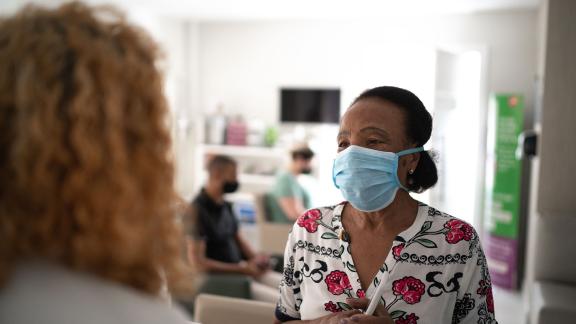Ways to Wellness: maternal mental health services

Ways to Wellness has worked with the local ICS and VCSE organisations to recruit and deploy invaluable maternal mental health support in four key neighbourhoods, connecting new and expectant mothers with local assets and support.
The neighbourhood
Ways to Wellness covers a broad area of the North East and North Cumbria ICB, with roughly 3 million residents, however it supports much smaller initiatives such as the maternal mental health project which is the focus of this case study.
The maternal mental health project covers four areas with a mix of urban and rural characteristics that have been selected as they are highly deprived, with mothers at risk of mental health challenges during pregnancy and in the early days of being a new mother.
The four areas were in Sunderland, North Cumbria, South Tees and Northumberland. The number of live births per year in each area ranges from 1,500 to 4,000 and the model supported 513 families over the course of 21 months. The model builds from existing maternity services in each area and is united by Ways to Wellness that provides vital support, funding, oversight and risk management.
The four areas share knowledge between them through a shared learning community, to learn from one another and collectively resolve shared challenges.
The context
The Maternal Mental Health Project responds to several gaps in services for expectant and new mothers and aims to make these more accessible to socioeconomically disadvantaged mothers.
Up to one-in-five women develop a mental health condition during pregnancy or within the first year after having a baby, these have a serious impact on the wellbeing of mothers and on the health of their babies.
The waiting lists for maternal mental health services are long, preventing timely access to support and this requires a different approach to support mothers.
Many women require non-clinical support in this period to help them in relation to budgeting, social connections, knowledge and skills.
This project aimed to support women with a non-clinical model, link workers from local VCSE organisations were employed to support women with very broad determinants of health and wellbeing.
The aim was to support the health and wellbeing of expectant and new mothers who were at risk of developing a mental health condition, or a mental health condition worsening with pregnancy. This would in turn reduce the reliance on mental health and primary care services and prevent more acute mental health challenges.
The model
Funding is provided by the North East and North Cumbria Mental Health ICS and Perinatal Mental Health Clinical Network team, as part of the NHS England Maternal Mental Health Fast Follower programme.
The model is a prototype and hence has time bounded funding, the evidence of impact of the model makes a strong case for continuation of the model and the spread of the model to other geographies.
The model has a delivery group, a steering group, and an evaluation group which have representation from VCSE, academic and NHS partners. which both have representation from VCSE and NHS partners.
The project focused on addressing the barriers to engagement with maternal mental health services by a close partnership between community infrastructure, VCSE and local NHS maternity services.
The model was co-designed with women experiencing various forms of deprivation, VCSE sector and health professionals.
The model uses a blend of different approaches, including social prescribing, ABCD and individual case management.
The model applied the same methodology in each of the four areas with provision of funding for a single full time equivalent link worker which could be used flexibly to employ two part-time link workers if appropriate.
The model is based upon a link worker operating in a defined neighbourhood. The link worker role is person-centred and develops a strong relationship with individual service users and linkages with local neighbourhood activities and support.
All link workers cover a different specified area and attend a shared training course, the Tavistock and Portman Introduction to Perinatal Mental Illness course, before starting their role and are further supported through the shared learning community.
The link worker role covers many activities including listening, goal setting, planning, linking with existing community assets or groups to address needs and share self-management tools.
What makes this effective and resilient
The project works because it is place-based, flexible, non-clinical and woman-centred. The project supports women at a crucial time, in an area where waiting lists in healthcare-based services are long enough to miss a critical window for intervention.
The role of the VCSE sector is vitally important in making service users comfortable to raise issues. Service users commented specifically on how they felt comfortable to discuss issues that would not have been raised with traditional healthcare.
The four areas have a learning community that meets to share knowledge and this itself generates a community asset and upskilling.
Linking mothers to family and community hubs has provided longevity of support and a connectedness to community which can endure after maternal mental health support.
Women and families who will most benefit will differ depending on local demographics and need. Link worker skills may need to include language, shared cultural background, etc.
The nature of support depends on other services available locally, and gaps in support.
The expansion and replication of this project is likely to bring similar benefits to other areas. There is strong support locally for the project to be expanded throughout the North East and Cumbria. However, new services will need to be designed to meet local needs.
“My little one is thriving, her confidence is growing, before coming to this group she hid away. It’s the highlight of both of our weeks, it’s impossible not to feel part of a family.”
Service User
What makes this challenging
There are challenges in managing differences of opinion between different community groups and reaching consensus rather than a path of least resistance and listening to the loudest voices. A collaborative rather than adversarial model is required to resolve these issues, but working in this way can be a new way of working for some partners.
Building relationships between the VCSE and NHS. A key lesson is that a preparatory period of building trust, particularly around safeguarding and governance, and agreeing how to work together was important. Existing NHS services can helpfully be involved at earlier project design stages, for example in selecting areas to target support. Relationships are now strong.
Different challenges are faced in rural areas compared with urban areas. In some areas there is a lack of venues to meet women, and travelling to venues is harder and expensive for women in rural areas. This requires the link worker to travel long distances.
There is a limit to the size of the area that a link worker can be expected to know if they are to be effective. This underscores the need to work at a neighbourhood level for link workers to provide an effective service. The largest project area (which is rural in its geography) was found to be too large for one link worker to cover. The learning from this is to define a neighbourhood at project inception, and ensure this neighbourhood is small enough for effective working to take place.
Impact and outcomes
The work was thoroughly evaluated by Ways to Wellness and the key impacts included cost savings, improved wellbeing of mothers and improved confidence of mothers to care for their children.
- 96 per cent of women made progress in at least one project outcome area; 87 per cent across at least two areas; 54 per cent across at least three areas.
- On average, ONS4 scores (a measure of personal wellbeing) show broad improvement, feedback from women particularly highlights a reported reduction in anxiety; we see a fall in women’s anxiety scores from an average of 8 to an average of 5 on ONS4.
- 76 per cent of women have experienced improved mental and emotional health, 51 per cent have an improved support network, and 49 per cent improved physical health.
- Increased life satisfaction, feeling that life is worthwhile and increased happiness and decreased feelings of anxiety following the project.
- The service was found to cost £491 per family (after initial development). This compares to a £8,795 cost to the healthcare system or a £34,811 cost to the public sector and wider society of one case of perinatal anxiety.
- The model did not explicitly evaluate the impact on the children of supported mothers, but it is reasonable to expect that this will have a positive impact on the lives and parenting experiences of the children, further magnifying a long-term impact of the model.
“I’d been in a really low place to be honest [without the service]. It’s nice to have a focus on the more positive. Maybe I can be something.”
Service User
Further information on this case study:



